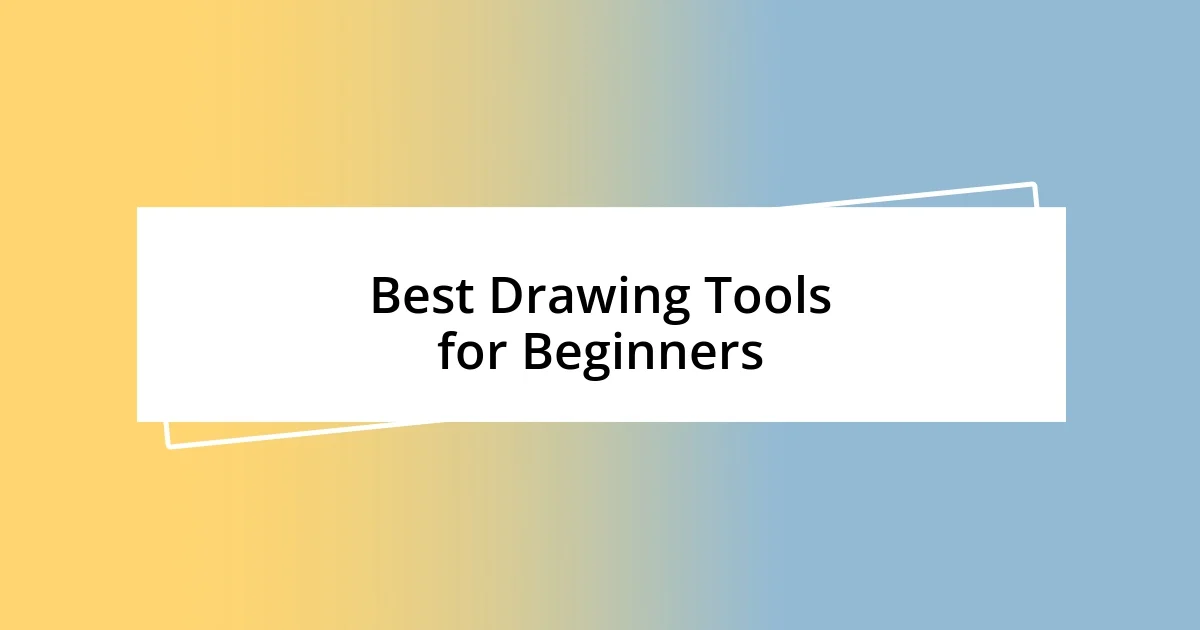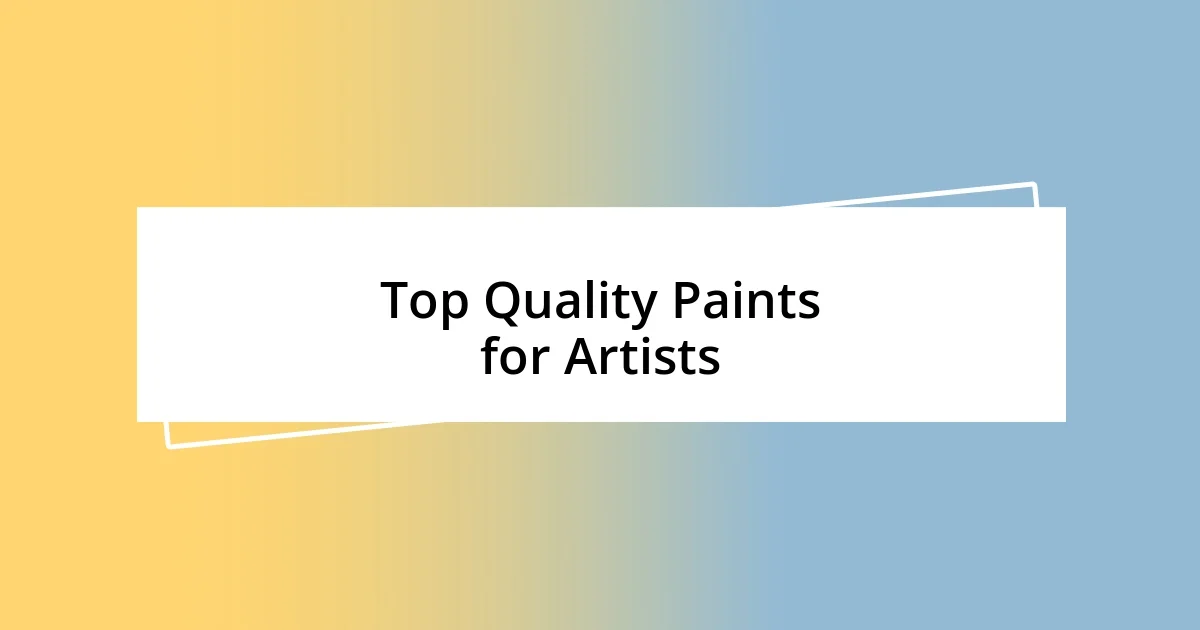Key takeaways:
- A good sketchbook and high-quality brushes are fundamental to enhancing creativity and artistic expression.
- Investing in professional-grade paints significantly improves artwork quality, providing better vibrancy and blending capabilities.
- Proper maintenance of art supplies, such as cleaning brushes and storing tools correctly, extends their lifespan and optimal performance.

Essential Art Supplies You Need
When I think of essential art supplies, the first thing that comes to mind is a good sketchbook. There’s something magical about the blank pages waiting for your thoughts, ideas, or doodles. Have you ever sat down with a fresh sketchbook and felt that rush of creativity? I can’t help but feel a burst of inspiration every time I open a new one; it’s like starting a new adventure.
Next on the list are high-quality brushes. Whether you’re painting in watercolors or acrylics, having a variety of brushes in different shapes and sizes can truly elevate your work. I remember investing in a set of brushes and seeing how they transformed my painting technique. It was as if they breathed new life into my artwork, allowing me to express my vision more precisely. Have you experienced how the right tool can change your approach?
Lastly, let’s not forget about colors! Quality paints, pastels, or pencils can make a world of difference. I once had a cheap set of paints that left me frustrated because the colors lacked vibrancy. When I finally tried professional-grade paints, I was amazed at how a single stroke could bring my artwork to life. What about you? Have you ever upgraded your supplies and noticed a significant difference in your creations?

Best Drawing Tools for Beginners
As a beginner, I always found that drawing tools made a huge impact on my artistic journey. Starting with a good set of graphite pencils can be a game changer. I remember my first pack of pencils—each one had a different hardness, allowing me to explore everything from delicate lines to bold strokes. It’s fascinating how a simple pencil can bring your imagination to life, right?
Here are some vital drawing tools for beginners:
– Graphite Pencils: Varying hardness (2H to 8B) lets you create different textures and depths.
– Erasers: A kneaded eraser is fantastic for precise corrections and highlights.
– Blending Stumps: These help in softening edges and creating smooth transitions in shading.
– Sketchbooks: Choose smooth pages to make sketching enjoyable and effortless.
– Kimberly Colored Pencils: Great for adding a splash of color without overwhelming your artwork.
When I first experimented with ink pens, it felt like my drawings finally had a voice. I distinctly recall the thrill of ink flowing smoothly onto the page, creating confident lines that made my sketches pop. That experience taught me how important it is to choose the right tools that resonate with your style.

Top Quality Paints for Artists
When it comes to quality paints, I often return to the rich experience of using professional-grade acrylics. I remember the first time I tried a high-end brand; the pigments were so vibrant, they practically sang on the canvas. The covering power was astonishing; I could layer without muddying my colors, and it completely changed how I approached each piece. Have you ever had that moment when your tools elevate your creativity?
Watercolors are another area where quality paints shine. I still recall the feeling of applying a rich blue watercolor onto a wet page, watching it bloom beautifully. The difference between student-grade and artist-grade paints is significant; the latter provides better transparency and mixing capabilities, allowing for those stunning gradients we all strive for. Have you noticed how the right paint can transform the mood of your artwork?
Oil paints also deserve a mention. The buttery consistency and blendability of premium oils make the painting process a true joy. I had an experience where I worked with a lesser quality set and found myself frustrated with the slow drying time and uneven application. Once I switched to an artist-grade brand, it felt like painting became a dance instead of a struggle. The colors became richer and more dynamic, bringing my artistic vision to life in ways I had only dreamed of.
| Type of Paint | Key Features |
|---|---|
| Acrylic | Fast-drying, versatile, great vibrancy |
| Watercolor | Transparent, easy blending, delicate washes |
| Oil | Slow-drying, rich texture, excellent blending |

Recommended Brushes for Different Mediums
When it comes to brushes, choosing the right one can truly enhance your experience in any medium. For watercolor painting, I wholeheartedly recommend using soft, round brushes. I remember the first time I dipped a large, round brush into water, feeling the bristles bloom as it loaded with pigment. There’s something magical about the way it glides effortlessly across the paper, helping to create those dreamy washes and fine details. Isn’t it amazing how a simple brush can initiate such beautiful transformations?
For acrylics, I find that flat brushes are my go-to. Their width makes them perfect for both broad strokes and sharp edges. I often reminisce about a particular piece I painted where I used a flat brush to blend vibrant colors seamlessly. The way the pigments mixed on the canvas had me hooked; it felt less like work and more like an exhilarating adventure. Have you ever experienced that delightful moment when the right brush makes your vision come alive?
If oil painting is your thing, then filbert brushes are where it’s at. I can’t count how many times they’ve helped me lay down a smooth blend of colors. There was one painting where I was struck by the urge to capture the softness of a sunset. Using a filbert brush, I gently stroked the canvas, creating these soft transitions that truly radiated warmth. The shape curves just right for blending edges—don’t you find it extraordinary how a well-designed tool can channel our creativity so effortlessly?

Useful Tools for Mixed Media
When it comes to mixed media, one tool that I find indispensable is a good palette knife. It’s remarkable how versatile this simple tool can be. I remember the first time I used one to create texture in my artwork; I was amazed at how I could scrape, spread, and lift paint in ways that my brushes couldn’t manage. Have you ever discovered a tool that completely changed your approach to a medium?
Another essential for mixed media is gel mediums. These magical substances can transform the consistency and finish of your paints. I once experimented with a heavy gel medium while layering different materials, and the results exceeded my expectations. The way it added depth and dimension to a flat piece was genuinely eye-opening. It almost feels like a secret weapon for making artwork pop, don’t you think?
Lastly, I can’t overlook the importance of quality spray fixatives. They might seem mundane, but the peace of mind they provide is invaluable. After finishing a mixed media piece packed with textures and delicate pigments, I recall my nervousness with the first spray. However, witnessing how it preserved my creation without disturbing any layers was such a relief. It’s a small step that feels like an essential ritual at the end of each piece. How do you keep your artwork safe and sound?

Maintenance Tips for Art Supplies
Maintaining your art supplies is crucial for ensuring they last and perform at their best. For instance, after every painting session, I make it a point to thoroughly clean my brushes in warm, soapy water. I still remember the first time I neglected to clean my brushes; the horror of discovering hardened paint on bristles that were once soft and pliable is a feeling I’ll never forget. Taking that extra few minutes to care for my tools truly pays off in the long run—what about you? Do you have a cleaning routine for your brushes?
For my pens and markers, I always cap them tightly and store them horizontally when possible. I once had a vibrant set of brush pens that dried out because I left them standing upright for too long. That experience taught me that simple storage can make a huge difference in how vibrant your colors remain. How do you usually store your drawing tools to keep them in top shape?
When it comes to my paints, especially watercolors, I ensure that I don’t leave them exposed to air for extended periods. I vividly recall a set of watercolors I cherished, which unfortunately cracked because I forgot to seal the lids properly. Now, I always check those caps before putting my supplies away. It’s such a simple maintenance tip, but it can save you so much frustration down the line! Have you ever lost a favorite color because of carelessness?













